
Frederic George Stephens was a British art critic, and one of the two 'non-artistic' members of the Pre-Raphaelite Brotherhood.

A Woman Peeling Apples is a painting by the Dutch Golden Age painter Pieter de Hooch in the Wallace Collection in London.

The Wallace Collection is a museum in London occupying Hertford House in Manchester Square, the former townhouse of the Seymour family, Marquesses of Hertford. It is named after Sir Richard Wallace, who built the extensive collection, along with the Marquesses of Hertford, in the 18th and 19th centuries. The collection features fine and decorative arts from the 15th to the 19th centuries with important holdings of French 18th-century paintings, furniture, arms and armour, porcelain and Old Master paintings arranged into 25 galleries. It is open to the public and entry is free.

Sir Richard Wallace, 1st Baronet, of Sudbourne Hall in Suffolk, Hertford House in London, of Antrim Castle, County Antrim, Northern Ireland, of 2 Rue Laffitte, Paris, and of the Château de Bagatelle in Paris, was a British art collector and Francophile. Based on the Return of Owners of Land, 1873 he was the 24th richest man in the United Kingdom and the 73rd largest landowner, holding in total 72,307 acres, with a total annual value of £86,737. In addition he had valuable property in Paris and one of the greatest private art collections in the world, part of which, now known as the Wallace Collection, was donated to the UK Government by his widow, in accordance with his wishes.

Sir Edwin Henry Landseer was an English painter and sculptor, well known for his paintings of animals – particularly horses, dogs, and stags. However, his best-known works are the lion sculptures at the base of Nelson's Column in Trafalgar Square.
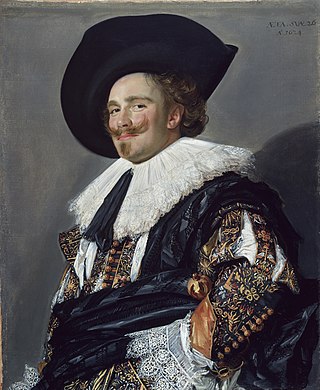
The Laughing Cavalier (1624) is a portrait by the Dutch Golden Age painter Frans Hals in the Wallace Collection in London, which has been described as "one of the most brilliant of all Baroque portraits". The title is an invention of the Victorian public and press, dating from its exhibition in the opening display at the Bethnal Green Museum in 1872–1875, just after its arrival in England, after which it was regularly reproduced as a print, and became one of the best known old master paintings in Britain. The unknown subject is in fact not laughing, but can be said to have an enigmatic smile, much amplified by his upturned moustache.

Francis George Hugh Seymour, 5th Marquess of Hertford, known as Francis Seymour until 1870, was a British army officer, courtier and Conservative politician. He served as Lord Chamberlain of the Household under Benjamin Disraeli from 1874 to 1879.
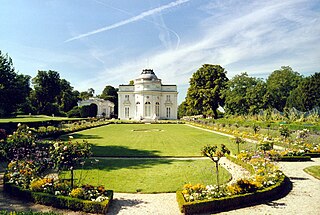
Captain Richard Seymour-Conway, 4th Marquess of Hertford KG was an English aristocrat and sometime politician who spent his life in France devoted to collecting art. From birth to 1822 he was styled Viscount Beauchamp and from 1822 to 1843 Earl of Yarmouth.

Francis Charles Seymour-Conway, 3rd Marquess of Hertford,, styled Viscount Beauchamp between 1793 and 1794 and Earl of Yarmouth between 1794 and 1822, of Ragley Hall in Warwickshire and of Sudbourne Hall in Suffolk, was a British Tory politician and art collector.

Henry William Eaton, 1st Baron Cheylesmore was a British businessman, Conservative politician, and art collector.
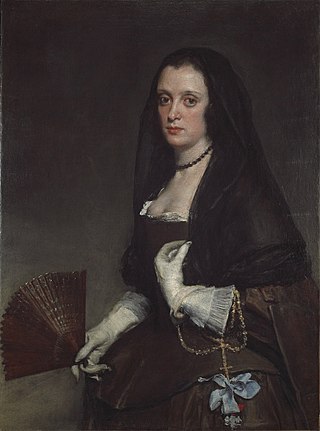
The Lady with a Fan is a major oil painting by the Spanish court painter Diego Velázquez. It depicts a woman wearing a black lace veil on her head and a dark dress with a low-cut bodice. On the basis of its place in Velázquez's stylistic development, the portrait is thought to have been painted between 1638 and 1639. It is now in the Wallace Collection in London.

The Horse Fair is an oil-on-canvas painting by French artist Rosa Bonheur, begun in 1852 and first exhibited at the Paris Salon in 1853. The artist added some finishing touches in 1855. The large work measures 96.25 in × 199.5 in.

A Dance to the Music of Time is a painting by Nicolas Poussin in the Wallace Collection in London. It was painted between c. 1634 and 1636 as a commission for Giulio Rospigliosi, who according to Gian Pietro Bellori dictated its detailed iconography. The identity of the figures remains uncertain, with differing accounts.
William Meriton Eaton, 2nd Baron Cheylesmore is best remembered as a leading collector of English mezzotint portraits, and collector of other art. His mezzotints and other prints, over 10,000 in number, were left to the British Museum, and five oil paintings to the National Gallery, London. He also stood unsuccessfully for Parliament for the Conservative Party at Macclesfield in 1868, 1874 and 1880, and held a nominal partnership in the family silk business.

A Young Archer is an oil painting, painted about 1640 by the Dutch Golden Age artist Govaert Flinck. The painting depicts a young black boy dressed as an archer. The painting is in the collection of the Wallace Collection, in London, England.

The Shepherd Paris is a c.1628 painting by the Flemish artist Anthony van Dyck, dating to just after the artist's return from Italy and showing the strong influence of Titian. It shows Paris during the Judgement of Paris, holding the golden apple he has been ordered to give to the most beautiful of three goddesses - unusually the artist focuses on Paris and does not show the goddesses themselves.
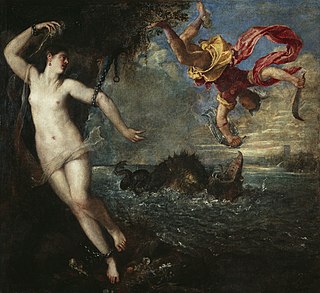
Perseus and Andromeda is a painting by the Italian Renaissance artist Titian, now in the Wallace Collection in London. It was painted in 1554–1556 as part of a series of mythological paintings called "poesie" ("poetry") intended for King Philip II of Spain. The paintings took subjects from the Roman poet Ovid's Metamorphoses, in this case Book IV, lines 663–752, and all featured female nudes.

Elhanan Bicknell was a successful London businessman and shipowner. He used his wealth as a patron of the arts, becoming one of the leading collectors of contemporary British art.
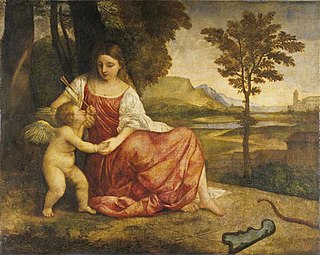
Venus and Cupid is a 1510–1515 oil on canvas painting by Titian, now in the Wallace Collection in London. It is dated by the model for Venus, who also appeared in other 1510s works by the artist such as his Salome.
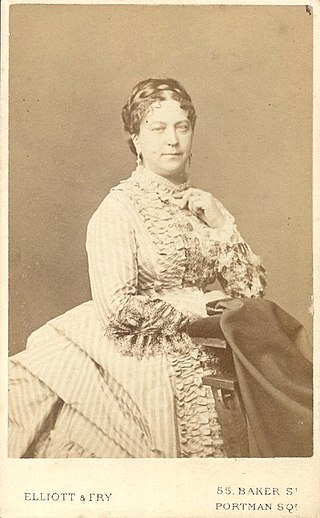
Julie Amelie Charlotte Castelnau, known from 1871 as Lady Wallace is best known today for her "bequest to the Nation" of about 5,500 artworks that resulted in the Wallace Collection, which opened in her marital home 13 years after her death. Her bequest was almost certainly in fulfilment of the wishes of her late husband Sir Richard Wallace, 1st Baronet, who together with his father and grandfather, the 3rd and 4th Marquesses of Hertford, had amassed the majority of the collection.




















